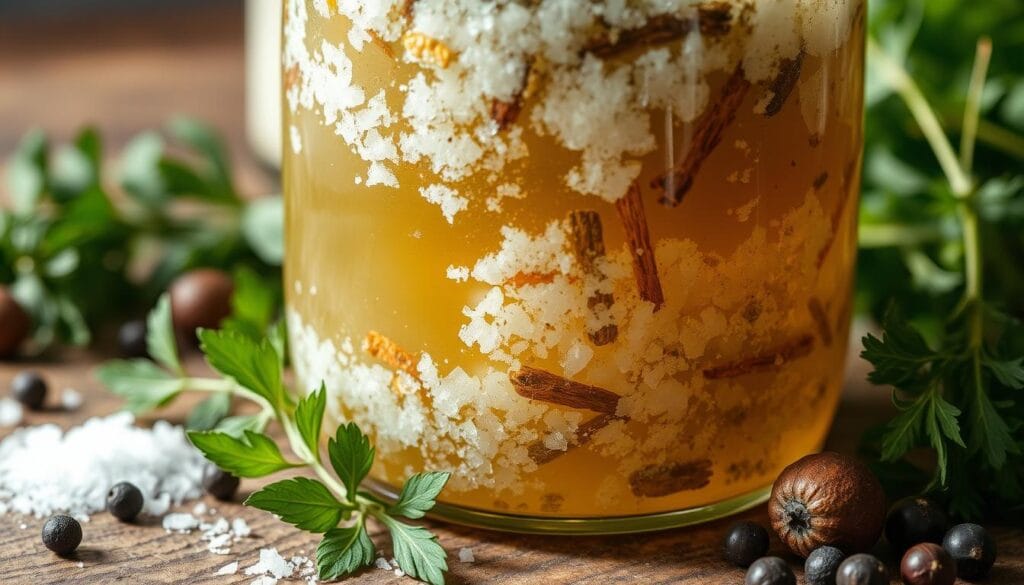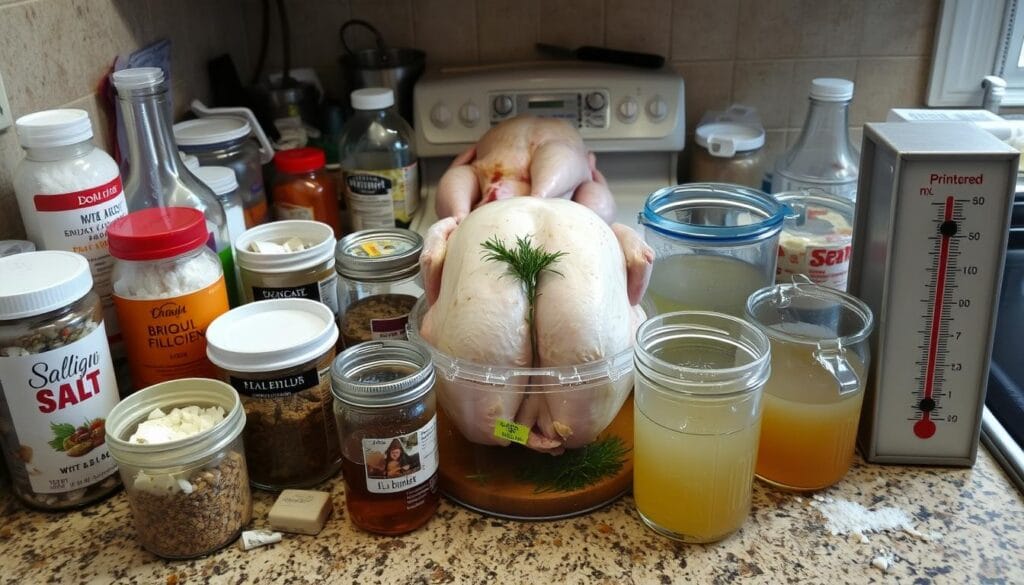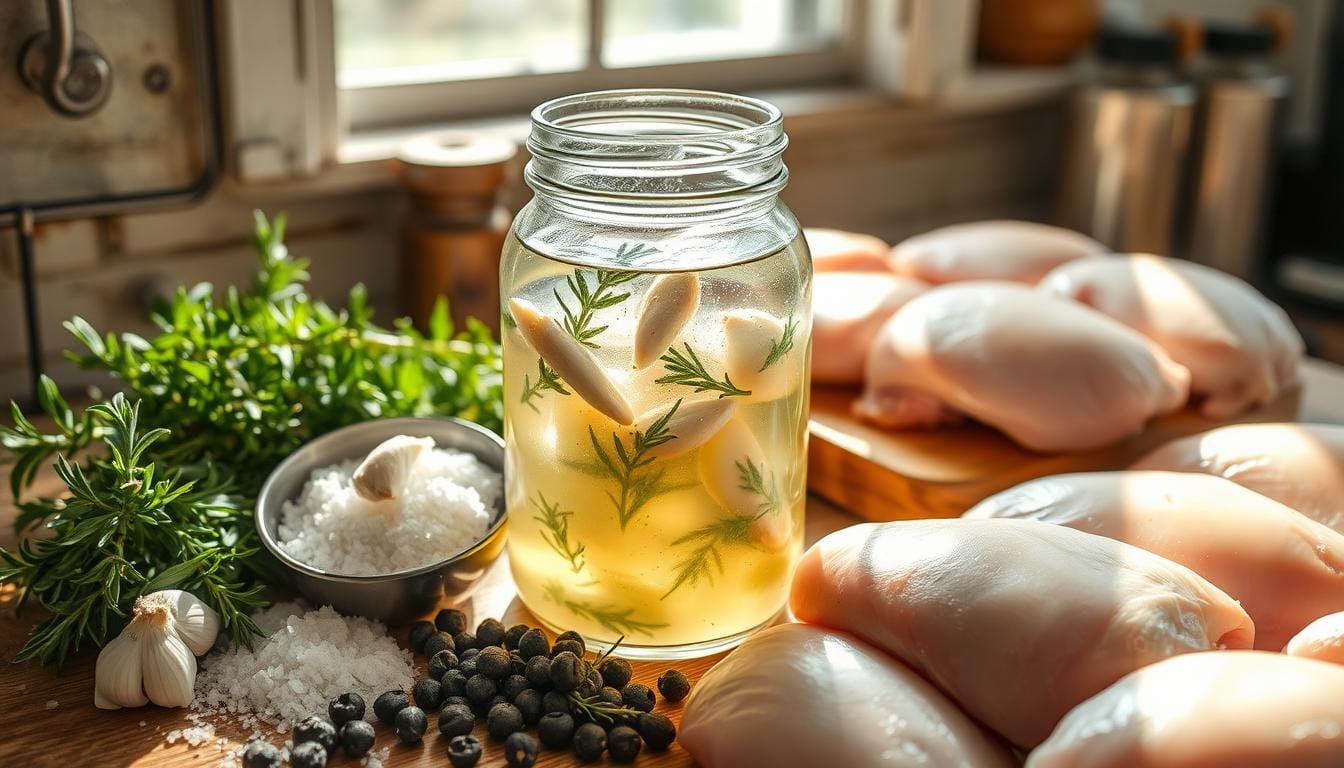Simple Chicken Brine for Beginners
As a home cook, I’ve faced the challenge of making juicy, flavorful chicken. That’s why I’m excited to share this simple chicken brine recipe with you. Brining is a game-changer that turns ordinary chicken into a mouthwatering masterpiece. Get ready to see the difference a little brine can make!
Table of Contents
Understanding the Basics of Chicken Brining
Brining is a simple yet transformative process that can elevate the flavor and texture of your chicken. By soaking the meat in a carefully crafted brine solution, you can unlock a world of juiciness and seasoning. This goes beyond conventional cooking methods. Understanding the science behind brining is key to achieving mouthwatering results every time.
What is Brining?
Brining is the act of submerging chicken in a saltwater solution, known as a brine. This solution typically contains a combination of salt, water, and sometimes additional flavorings like herbs, spices, or aromatics. The brine works its magic by breaking down the protein structures in the meat. This allows it to better absorb moisture and seasonings.
Why Brine Your Chicken?
Brining your chicken offers a host of benefits. It helps prevent the meat from drying out during cooking, resulting in juicier, more tender pieces. The brine also infuses the chicken with a subtle yet delightful flavor. This elevates the overall taste experience. Whether you’re grilling, roasting, or frying your chicken, brining can make a noticeable difference in the final outcome.
Science Behind Brining
The science behind brining is rooted in the principles of osmosis and protein denaturation. When the chicken is submerged in the brine solution, the salt and other dissolved particles begin to penetrate the meat. This causes the protein structures to unwind and become more pliable. This allows the chicken to better retain moisture during the cooking process, leading to a juicier, more tender texture.
Out of the brine testing done, it was found that chicken breasts brined for 30 minutes to one hour were perfectly seasoned, juicy, and tender. There was a noticeable difference in texture and tenderness.
Essential Ingredients for Simple Chicken Brine
Making a flavorful chicken brine is easy and can make your chicken dishes better. The key parts are water and salt. These are the base for a tasty wet brine that makes chicken juicy and tender.
Core Components
The main things you need for a basic chicken brine are:
- Water
- Salt
Optional Aromatics and Seasonings
You can add extra flavors to your brine with:
- Sugar (brown or white)
- Soy sauce
- Olive oil
- Herbs (rosemary, thyme, sage)
- Garlic
- Citrus (lemon, orange, lime)
- Spices (peppercorns, allspice, bay leaves)
Measuring Guidelines
A good starting point for the brine is 2 tablespoons of salt per liter of water. It’s best to weigh the ingredients, especially the salt. This helps make a balanced brine for your chicken.
| Ingredient | Quantity |
|---|---|
| Water | 6 cups (1.4 liters) |
| Salt | 3 tablespoons (45 grams) |
| Sugar | 2 1/2 tablespoons (35 grams) |
The great thing about a simple chicken brine is you can try different flavors. Mix and match aromatics and seasonings to find your favorite taste.
How to Make a Simple Chicken Brine
Making a flavorful and juicy chicken starts with a simple brine recipe. This easy process adds moisture and flavor to your chicken. It ensures your chicken tastes great every time. Let’s go through the steps to make your own chicken brine at home.
Start by dissolving salt in warm water. Use 2 tablespoons of salt per liter of water for a 3% salt solution. For a big chicken, you’ll need about 4 liters or 1 gallon of brine.
To add more flavor, think about adding soy sauce, sugar, and olive oil. Soy sauce gives a savory taste, sugar balances the salt, and olive oil adds richness. Mix everything well until the salt and sugar dissolve.
Let the brine cool down to room temperature before adding your chicken. For faster cooling, use an ice bath. Once it’s cool, put your chicken in and make sure it’s fully covered.
Brining times depend on the chicken cut. Here’s a basic guide:
- Skinless breasts: Brine for 2 hours
- Bone-in pieces: Brine for 4 hours
- Whole chickens: Brine for at least 4 hours, or up to overnight
After brining, pat the chicken dry before cooking. This helps get a crispy, golden skin. With just a few steps, you can make your chicken dishes more flavorful with a brine recipe.
Perfect Brine-to-Water Ratios
Creating the perfect brine mixture for chicken is all about finding the right balance. You need to mix the salt concentration with the right amount of water. A standard brine solution uses 2 tablespoons (30 grams) of kosher salt for every 1 liter of water. This makes a 3% salt concentration.
This ratio helps dissolve parts of the protein structure. It makes the wet brine work its magic. Your chicken will be juicy and full of flavor.
Salt Concentration Guidelines
While 3% salt is a good start, you can adjust it to your liking. Try using 3/4 cup (180 grams) to 1 cup (240 grams) of coarse kosher salt for every 1 gallon (4 liters) of water. This range helps create the best brine mixture.
Water Temperature Tips
- Start with warm water to dissolve the salt and any extra seasonings or sugars. This ensures the brine solution is fully mixed.
- After dissolving the salt and other ingredients, cool the brine mixture quickly. You can do this by placing the container in an ice bath or refrigerating it until it’s chilled.
Keeping the water at the right temperature is key for brining and safety. By following these tips, you can make a perfect brine mixture. It will turn your chicken into a juicy, flavorful treat.

Brining Times for Different Cuts
Brining chicken makes a big difference. It boosts flavor, texture, and juiciness. But, the brining time changes with the chicken cut. Knowing the right brining time for each cut is key to great results.
Skinless, boneless chicken breasts need 1 to 2 hours in the brine. This keeps them juicy and tender. Skin-on, bone-in chicken should soak for 2 to 3 hours. This lets the brine soak deep into the meat.
Whole chickens need 3 to 4 hours, or even overnight, to soak up all the flavors. This ensures the whole bird is seasoned evenly.
Be careful not to brine too long. It can make the meat too salty. Adjust brining times based on the chicken’s thickness and size.
| Cut of Chicken | Brining Time |
|---|---|
| Skinless, Boneless Chicken Breasts | 1 to 2 hours |
| Skin-on, Bone-in Chicken | 2 to 3 hours |
| Whole Chicken | 3 to 4 hours, or up to overnight |
Brining is a great way to improve your chicken dishes. It makes them juicy and full of flavor. By knowing the right brining times, you can season and cook your poultry perfectly.
Common Brining Mistakes to Avoid
Brining your chicken can make it juicy and flavorful. But, there are common mistakes to watch out for. One big mistake is over-brining, which can make your chicken taste too salty and feel spongy. The right amount of salt is 1 tablespoon per 1 cup of liquid for a simple chicken brine.
Keeping the brine solution at the right temperature is also key. If it gets too warm, bacteria can grow, which is bad for food safety. It’s best to keep the brine solution cold in the fridge while you brine.
Choosing the wrong container is another mistake. Don’t use aluminum or cast iron because they can give your wet brine off-flavors. Instead, use stainless steel, enameled pots, brining bags, or high-quality plastic buckets. Make sure the chicken is fully covered to season it evenly.
Avoiding these common mistakes will help you make perfectly juicy, flavorful chicken every time.
| Mistake | Potential Outcome | Solution |
|---|---|---|
| Over-brining | Overly salty, spongy texture | Follow recommended brine-to-water ratios and brining times |
| Temperature control issues | Bacterial growth, food safety concerns | Keep the brine solution chilled in the refrigerator |
| Inappropriate container selection | Off-flavors from reactive materials | Use food-grade, non-reactive containers like stainless steel or enameled pots |

“By avoiding these common brining mistakes, you’ll be able to achieve perfectly juicy, flavorful chicken every time.”
Best Containers and Equipment for Brining
Brining your poultry is a simple yet effective way to enhance the flavor and juiciness of your chicken. But to achieve the best results, it’s essential to use the right containers and equipment. After all, the brine mixture needs to fully submerge and surround the meat for optimal absorption.
When it comes to wet brine containers, food-grade, non-reactive options are your best bet. Stainless steel or enameled stockpots make excellent choices, as they won’t react with the acidic components in the brine. Brining bags, which are essentially large, sealable plastic pouches, are another convenient option that allows the chicken to be fully immersed.
- For larger poultry like turkeys, consider using a clean, food-grade plastic bucket with a tight-fitting lid. This will ensure the bird is completely submerged in the brine mixture.
- Regardless of the container you choose, make sure it’s large enough to accommodate the chicken or turkey, with enough room for the brine to fully cover the meat.
- The container should also be able to fit comfortably in your refrigerator or a cool storage area, as maintaining the proper temperature is crucial during the brining process.
By selecting the right containers and equipment, you’ll be well on your way to achieving perfectly brined poultry every time.
“Brining is a simple yet powerful technique that can transform even the most basic chicken into a juicy, flavorful masterpiece.”
How to Properly Store Brined Chicken
Storing brined chicken right is key to keeping it fresh and safe. Whether you’ve just brined it or have leftovers, knowing the right storage tips is crucial.
Temperature Requirements
Always keep brined chicken in the fridge at 40°F (4°C) or lower. If you brined it at room temperature, do it for no more than 2-3 hours. For longer brining, refrigerate the chicken to keep it safe.
Make sure the chicken stays covered in brine while it’s stored. This stops air from getting to it, which can cause bacteria to grow.
Safety Guidelines
- Pat the chicken dry with paper towels after brining, before cooking or storing.
- If you won’t cook the chicken right away, store it in the fridge for up to 24 hours.
- Don’t let brined chicken sit at room temperature for too long, as bacteria can grow.
- When reheating, make sure the chicken reaches 165°F (74°C) to kill off any bad bacteria.
By sticking to these guidelines, your brined chicken will stay fresh, tasty, and safe to eat.
The brining process adds water, salt, and seasonings to the chicken. So, it’s important to handle and store it correctly to keep its quality and prevent foodborne illnesses.
From Brine to Cook: Preparation Steps
After soaking the chicken in the brine, it’s time to cook. Remove the chicken from the brine and throw away the used solution. Rinse the chicken under cool water, then dry it with paper towels.
For the crispiest skin, let the chicken air dry in the fridge for 30 minutes. This step is crucial.
When cooking the chicken, remember it cooks faster than non-brined chicken. Use a meat thermometer to check if it reaches 165°F (74°C). This ensures the chicken is safe to eat and perfectly cooked.
By rinsing, drying, and monitoring the cooking, you’ll get moist and flavorful chicken. The marinade and cooking methods will make your meal taste like it came from a restaurant.

